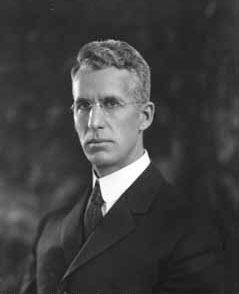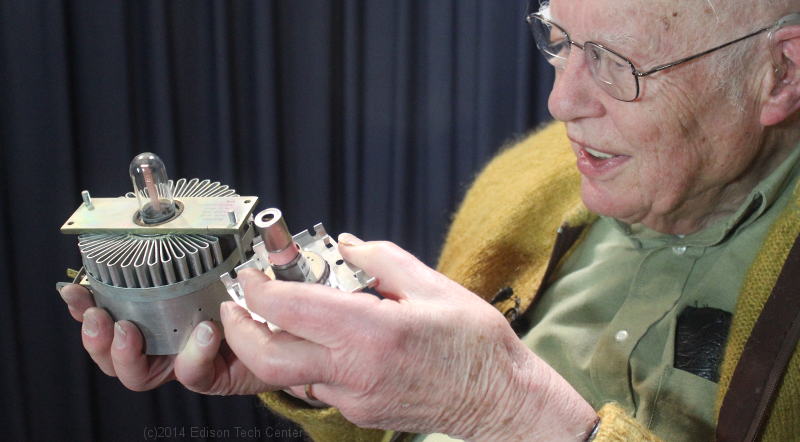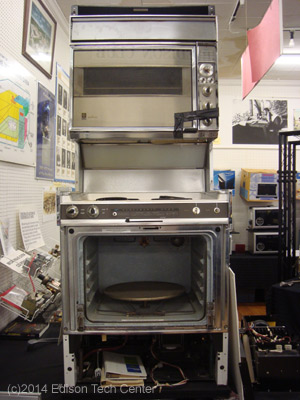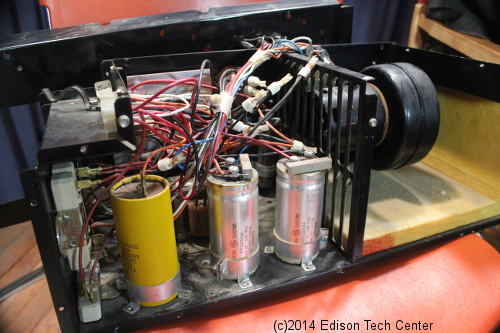Microwave Ovens
Microwave ovens are one of a few electric methods of cooking. The microwave oven evolved from research on Doppler radar technology by accident when a researcher (Percy Spencer at Raytheon) found a chocolate bar in his pocket had melted when he was exposed to microwave radiation.
1.) How it Works
1.a) The Magnetron
2.) High
Frequency Power Supply
3.) Notes on the History
1.) How it Works:
The microwave oven uses a magnetron to generate microwave energy. The microwave energy travels through a waveguide and is distributed into a metal cavity where the food is cooked. The waves are absorbed by the food and excite water molecules in the food. This heat then transfers throughout the food cooking it.

The microwave oven is faster than a conventional oven because the microwaves can penetrate into the food and heat the food from the inside out. In a conventional oven heat comes from the outside and slowly works its way into the food through standard slow heat transfer processes.
1.a) The Magnetron
 |
|
Video below: Mr. Rudy Dehn was one of the original developers of the microwave oven at
General Electric in the 1960s and 70s. He tells us how the microwave
works and shows us older magnetrons vs the current magnetron:

Above: older magnetrons were more fragile and larger than newer magnetrons. Invention of better ceramics helped make it more robust. Magnetrons are a type of oscillator which eject electrons from a coated filament. This is similar to how a vacuum tube operates.
 |
|
|
Right: One of the first freestanding ranges with a microwave oven for sale to the public was developed by General Electric. The microwave energy was transmitted from the magnetron under the oven to a glass dome in the back top of the oven through a waveguide (915 MHz). The energy was then emitted into the cavity heating the food. Modern microwave ovens still use waveguides to deliver the microwave energy from the magnetron to the cavity. Below is the 1960s era power supply used with the oven on the right.
|
 |
3.) Notes on the History of the Microwave Oven
The microwave oven began as the product shown above - a three level appliance with
standard oven on top, range in the middle and large microwave assisted by Calrod elements below.
It was believed that the main use of the microwave would be to speed up roasting turkeys and other large items, and thus
the Calrod element was needed. Later on the device
was changed into the counter-top appliance we know today.
Below Mr. Rudy Dehn recalls the early days of the 915 MHz
microwave oven at Louisville at General Electric:
"I was part of a GE delegation at a hearing
before the FCC to urge retaining 915 MHz
designation to continue because of greater `skin
depth' at the lower frequency.
Of course, as things developed, users were much
more interested in quickly cooking or reheating
much smaller items.
The GE oven depended on an
elastomer-cored metal mesh gasket for sealing the door.
It took only a few food spills to gunk up that
gasket whereupon the shielding deteriorated and
significant microwave power escaped. That
resulted in quite a recall and hastened the demise of
that product.
Percy Spenser is regarded as the person who
came up with the oven concept but since Raytheon
had no experience in appliances, they
negotiated a deal with Amana and the Radar Range ensued.
As the Japanese developed countertop
units, the concept of a combined thermal/microwave
product became history."
-Rudy Dehn
The Cavity Magnetron >
More on the history of "Radar and the Microwave Oven" >
Related Topics:
|
Vacuum Tubes |
Electric Ranges and Calrods |
Induction Cooktops |
12 Major Forms of Electric Light |
Radio |
More Stuff |
Article by M.Whelan, R. Dehn and W.Kornrumpf
Sources:
Interview with Rudy Dehn. Edison Tech Center. 2012
Interview with Bill Kornrumpf. Edison Tech Center. 2012
Albert Hull - Engineering Hall of Fame. Edison Tech Center. 2007
Photos:
Edison Tech Center
Whelan Communications


